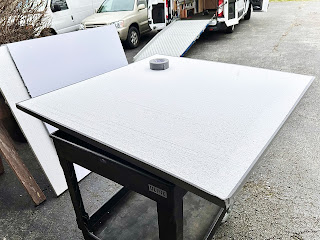It's spring, a perfect time for cleaning and maintenance.
I made up new 4x4' beadboard bounces last week. It's been overdue. The ones I had were starting to look battered. Best practice is to have a clean, flat beadboard.
 |
| I was out of 2" white tape and used gray. I covered it with white later. |
Beadboard bounces--I've heard some Canadian DPs call them "polys"--are an ubiquitous tool on set. Easy to rig or hand hold, the light-weight beadboard gives a soft light whether the source is passive or direct. It is one of the first tools I can remember learning on set when I was a young, green, grip/electric.
Beadboard is white expanded polystyrene foam board insulation. It is inexpensive. It usually comes in 1"x4'x8' sheets. It is not hard to find in stores though I've noticed some of the big box home improvement stores no long carry it.
Construction of a beadboard is simple. Take one 4x8' sheet of white foam core and one 4x8' sheet of beadboard. Cut each in half into 4x4' sheets (or whatever size you are wishing to make). Take 2" white gaffer tape and tape the 2 sheets together at the edges completely covering all 4 edges. That's it. You're done.
Beadboard on it's own has little strength. It breaks easily. That is the reason for the foamcore supporting it.
The reason for wrapping all 4 edges of the beadboard is to protect the edges of the fragile beadboard and keep it from shedding little white beads of polystyrene everywhere.
Beadboards are in a sense an expendable. They can last a long time if taken care of, but at the same time, it is not unusual for one to get destroyed in use. It is an inexpensive tool and sometime you need to use them in not-ideal situations. For example, rain will often ruin them.
 |
| Here's a beadboard bounce in the rain meeting it's demise. It was ruined by the time we were done. That's me standing in the rain. I think I was done, too. Thanks to Solomon for the great picture. |
When the beadboard gets worn and dirty it can be made new again by un-taping the sheets, flipping them around, and taping it back together. Voila! It's a new beadboard.
Of course, beadboards don't only have to be in a 4x4' size: a 2x2' "pizza box" size is great (I keep one in my flag box); a 2x4' sizes can be handy (I just recently heard a grip call it a "surf board"); and for a really nice big soft bounce, a 4x8' is awesome.
A 4x4' beadboard is such simple and inexpensive tech, I am constantly surprised by rental houses/grips not following best practices and have a clean, white, flat, beadboard.
Not best practices I see all the time: old dirty beadboard that is not white; beadboard that is badly warped; beadboard that is cracked and broken; beadboard with no foamcore backing--it is too flimsy to put in a holder; beadboard with no tape around the edges getting white bits of polystyrene everywhere; beadboard that is not polystyrene but something kinda white; etc.
Beadboard is cheap, and simple to make. There is no excuse to not have a good one on set.
PS: Another not-best-practices I see sometimes are grips using the foamcore side for a bounce instead of the beadboard side. I know this is a subjective one, but almost always, they are using the wrong side.
PPS: I sometimes see the an alternative bounce on the foamcore side like soft-silver or muslin; not a bad idea.
